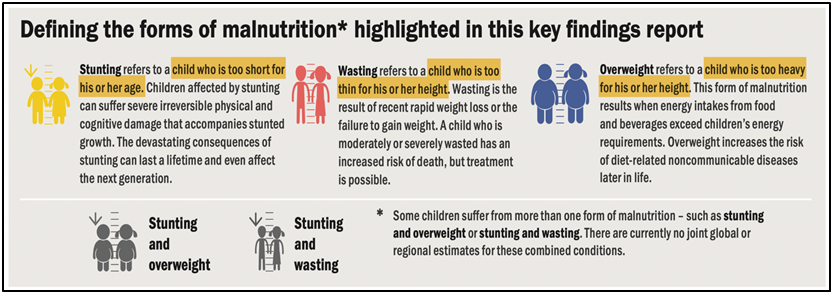Why in News?
- An inter-agency team of UNICEF, WHO and the World Bank has released the Joint Child Malnutrition Estimates (JME) report for 2022.
What’s in Today’s Article?
- About JME Report (Purpose, Key Highlights)
- Way Forward
About Joint Child Malnutrition Estimates (JME) Report:
- JME is an annual report published jointly by UNICEF, WHO and World Bank.
- The report covers measures of child malnutrition used to track progress towards the child nutrition targets of Sustainable Development Goal 2.
- The report covers child stunting, overweight, underweight, wasting and severe wasting.
Key Highlights of the JME Report 2022:

- Stunting –
- Child stunting refers to a child who is too short for his or her age and is the result of chronic or recurrent malnutrition.
- Globally, stunting declined from a prevalence rate of 26.3% in 2012 to 22.3% in 2022.
- India continues to show a reduction in stunting and recorded 1.6 crore fewer stunted children under five years in 2022 as compared to 2012.
- Stunting among children under five years dropped from a prevalence rate of 41.6% in 2012 to 31.7% in 2022.
- Wasting –
- Child wasting refers to a child who is too thin for his or her height and is the result of recent rapid weight loss or the failure to gain weight.
- The overall prevalence of wasting in 2022 was 18.7% in India.
- India contributes 49% of the global burden of wasting.
- In India, two-thirds of children at 12 or 24 months had wasting at birth or at one month of age. This means two-thirds of the wasting is caused by maternal malnutrition.
- Overweight –
- Childhood overweight occurs when children’s caloric intake from food
and beverages exceeds their energy requirements.
- There are now 37 million children under five living with overweight globally, an increase of nearly 4 million since 2000.
- India had an overweight percentage of 2.8 per cent in 2022, compared to 2.2 per cent in 2012.
Comments on India:
- Going by the JME data, UNICEF concludes that India has shown promising progress when it comes to stunting.
- According to UNICEF India officials, multi-sectoral responses under Poshan Abhiyaan in 2018 and continued Poshan 2.0 in 2022 seem to be contributing to the positive shift in the indicators.
Way Forward:
- JME released in 2023 reveal insufficient progress to reach the 2025 World Health Assembly (WHA) global nutrition targets and UN-mandated Sustainable Development Goal target 2.2.
- Only about a third of all countries are ‘on track’ to halve the number of children affected by stunting by 2030.
- All forms of malnutrition are preventable.
- To stop malnutrition before it starts, children and their families need access to nutritious diets, essential services and positive practices to set them on the path to survive and thrive.
- But today, these vital pathways to good nutrition are under growing threat, as many countries plunge deep into a global food and nutrition crisis fuelled by poverty, conflict, climate change and the COVID-19 pandemic.
- As the world responds to the crisis, urgent action is critical to protect maternal and child nutrition – especially in the most affected regions – and secure a future where the right to nutrition is a reality for every child.









